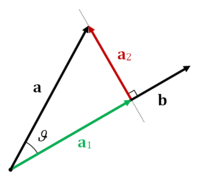Scalar projection


In mathematics, the scalar projection of a vector on (or onto) a vector , also known as the scalar resolute of in the direction of , is given by:
where the operator denotes a dot product, is the unit vector in the direction of , is the length of , and is the angle between and .
The term scalar component refers sometimes to scalar projection, as, in Cartesian coordinates, the components of a vector are the scalar projections in the directions of the coordinate axes.
The scalar projection is a scalar, equal to the length of the orthogonal projection of on , with a negative sign if the projection has an opposite direction with respect to .
Multiplying the scalar projection of on by converts it into the above-mentioned orthogonal projection, also called vector projection of on .
Definition based on angle θ
If the angle between and is known, the scalar projection of on can be computed using
Definition in terms of a and b
When is not known, the cosine of can be computed in terms of and , by the following property of the dot product :
By this property, the definition of the scalar projection becomes:
Properties
The scalar projection has a negative sign if degrees. It coincides with the length of the corresponding vector projection if the angle is smaller than 90°. More exactly, if the vector projection is denoted and its length :
- if degrees,
- if degrees.